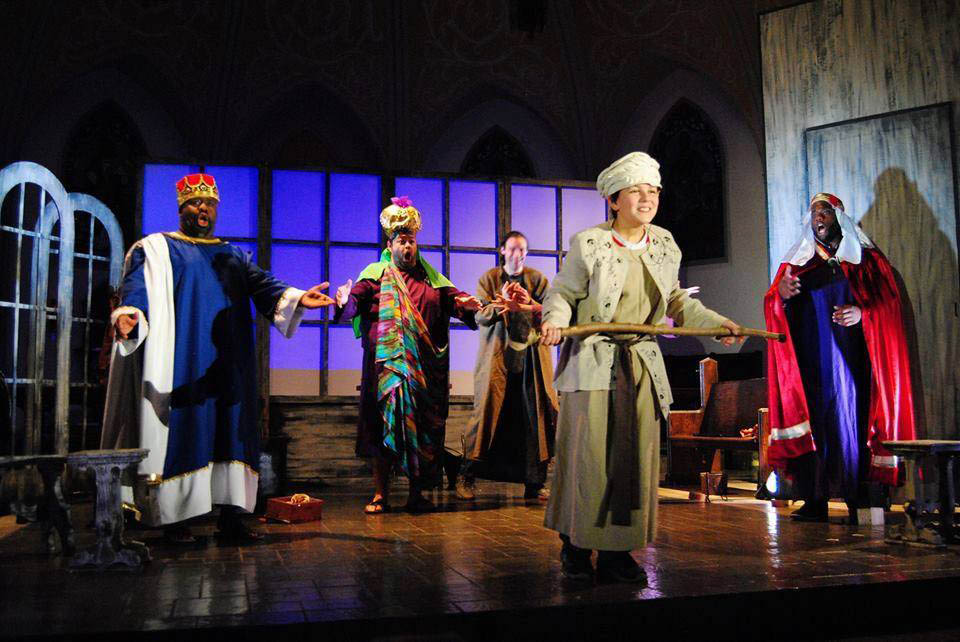Downtown Knoxville was—to say the least—packed last Friday evening. The seasonal Knoxville Christmas parade drew a huge throng of families and interested parties to Gay and adjacent streets. And, shows at the Tennessee and Bijou Theatres added to what would have been the usual large First Friday crowd making the rounds of galleries, retail establishments, and restaurants. In some ways, though, the most notable attraction was one that bodes well for the future of a diverse art scene in Knoxville—Marble City Opera’s production of Menotti’s Amahl and the Night Visitors at St. John’s Episcopal Cathedral. (Catch up on the story of Marble City Opera in my preview in the Knoxville Mercury)
Prior to this production, MCO, as a chamber opera company, had made use of the few smallish venues around downtown that could minimally support a theatrical effort: Remedy Coffee in the Old City, the Square Room, the Black Box space, NV Nightclub, and Relix. However, due to the size of St. John’s, their sponsorship of the performance, and the appeal of Amahl as an operatic piece, the audience for it numbered in the several hundreds Friday evening. The Sunday afternoon matinee audience was even larger, appearing to this observer to be a completely full house, or full pews, as it were.

Despite the extreme technical and artistic limitations of performing in the non-theatrical environment of a church, this MCO production of Amahl and the Night Visitors was, in many ways, its most accomplished one to date. Artistic director and soprano Kathryn Frady Marvel assembled a cast that included herself in the role of Amahl’s exasperated but loving mother, and featured an remarkably strong and appealing trio singing the role of the Kings: Vincent Davis (King Kaspar), Dominick White (King Melchior), and Daniel Webb (King Balthazar). Each of the three, each with rich and attractive voices, created distinctly motivated and likable characters that carried well, even to the rear of the church. Bass Peter Johnson proved decisively that there are no small roles by creating a solidly thought-out character for the Page, despite having only a couple of measures of music.
In the role of Amahl was Josiah Mustaleski (Friday) and Joseph Coram (Sunday). Both boy sopranos were accomplished vocalists and drew respect for tight dramatic, and emotionally touching, performances. Stage director James Marvel miraculously conquered the limitations of the church space and the audience’s vision by giving the singers visually interesting and exaggerated movement that was humorously mock-melodramatic. He also used the entire nave for attention-catching entrances and exits and added strategically suggestive scenic pieces to form the acting space of Amahl’s impoverished home.
Ace Edewards, conducting the 15 piece instrumental ensemble, certainly deserved his applause for the masterly job of keeping the performance pace necessarily tight, the ensemble and voices carefully balanced, and for sculpting a lot of musical character from the textural details of Menotti’s score.
The excellent chorus—in this case a chorus of shepherds—also deserved their applause for contributing to the professional strength of the production: Noelle Harb, D.C. Miles, Ryan Colbert, Michael Gonzalez, Melanie Burbules, Taylor Colton Stone, Maggie Ramsey, Maurice Hendricks, and Scott Beasley. The dancer was Whitney Flautt.
Needless to say, the issues of venues for organizations like Marble City Opera and other small professional theatre efforts will need to be addressed in discussions as downtown Knoxville’s revitalization moves into its next phase. Clearly, downtown lacks performance spaces such as a small hall for recital-type performances, chamber music, and other acoustic ensembles—and a modern, equipped space for theatrical performances that can’t make use of the size of the Bijou or Tennessee theaters. It is equally clear that any such spaces will have to be included in mixed-use new construction. However, the conversation should start now if we are to avoid a space-limited arts scene in the future.








